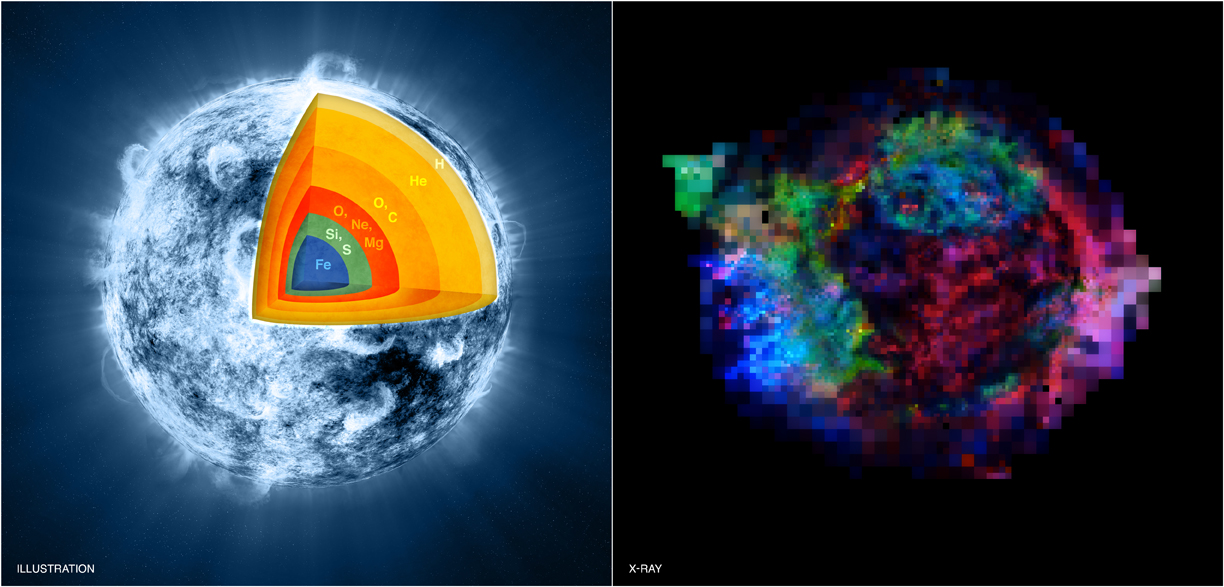Supernova Explosion Ripped Star's Guts Inside Out

A massive supernova explosion that destroyed a faraway star apparently turned the left over stellar corpse inside out as well, scientists say.
Using NASA's Chandra X-ray Observatory spacecraft, a team of researchers mapped the distribution of elements in the supernova remnant Cassiopeia A (Cas A for short) in unprecedented detail. They found that Cas A — which is located about 11,000 light-years from Earth and exploded 300 years ago from our perspective — is wearing its guts on the outside.
Before it went supernova, the star Cas A likely had an iron-rich core that was surrounded by layers of sulfur and silicon, which were in turn overlaid by magnesium, neon and oxygen, researchers said.
Chandra's observations showed that, after the explosion, most of that iron has now migrated to Cas A's outer edges. Neither Chandra nor NASA's Spitzer Space Telescope, which is optimized to see in infrared wavelengths, has detected any iron near the supernova remnant's center, where the element was originally formed.
Further, much of the silicon, sulfur and magnesium are now found on the outside of the still-expanding debris shell. Neon distribution hasn't changed much, and not much can be said about the oxygen because its X-ray emissions are strongly absorbed along the line of sight to Cas A.
Overall, this distribution of elements suggests that an instability in the supernova explosion process somehow turned the star inside out, researchers said. These latest Chandra observations, which are based on more than 11 days of observing time, are the most detailed study ever made of X-ray-emitting debris in Cas A, or in any other supernova remnant, they added.
The researchers estimate that the total amount of X-ray emitting debris has a mass just over three times that of our sun. Researchers found clumps of almost pure iron, indicating that this material must have been produced by nuclear reactions near the center of the pre-supernova Cas A.
Breaking space news, the latest updates on rocket launches, skywatching events and more!
The study's findings are detailed in the February edition of the The Astrophysical Journal.
The Chandra X-ray Observatory launched aboard the space shuttle Columbia in 1999 and has been observing the heavens ever since. It's one of NASA's "Great Observatories," a class of space telescopes that also includes Spitzer and the iconic Hubble Space Telescope.
Follow SPACE.com for the latest in space science and exploration news on Twitter @Spacedotcom and on Facebook.

Space.com is the premier source of space exploration, innovation and astronomy news, chronicling (and celebrating) humanity's ongoing expansion across the final frontier. Originally founded in 1999, Space.com is, and always has been, the passion of writers and editors who are space fans and also trained journalists. Our current news team consists of Editor-in-Chief Tariq Malik; Editor Hanneke Weitering, Senior Space Writer Mike Wall; Senior Writer Meghan Bartels; Senior Writer Chelsea Gohd, Senior Writer Tereza Pultarova and Staff Writer Alexander Cox, focusing on e-commerce. Senior Producer Steve Spaleta oversees our space videos, with Diana Whitcroft as our Social Media Editor.
